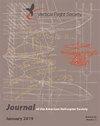Rotorcraft Lateral-Directional Oscillations: The Anatomy of a Nuisance Mode
IF 1.4
4区 工程技术
Q2 ENGINEERING, AEROSPACE
引用次数: 1
Abstract
High-fidelity rotorcraft flight simulation relies on the availability of a quality flight model that further demands a good level of understanding of the complexities arising from aerodynamic couplings and interference effects. One such example is the difficulty in the prediction of the characteristics of the rotorcraft lateral-directional oscillation (LDO) mode in simulation. Achieving an acceptable level of the damping of this mode is a design challenge requiring simulation models with sufficient fidelity that reveal sources of destabilizing effects. This paper is focused on using System Identification to highlight such fidelity issues using Liverpool's FLIGHTLAB Bell 412 simulation model and in-flight LDO measurements from the bare airframe National Research Council's (Canada) Advanced Systems Research Aircraft. The simulation model was renovated to improve the fidelity of the model. The results show a close match between the identified models and flight test for the LDO mode frequency and damping. Comparison of identified stability and control derivatives with those predicted by the simulation model highlight areas of good and poor fidelity.旋翼飞机横向方向振荡:一种干扰模式的剖析
高保真旋翼机飞行模拟依赖于高质量飞行模型的可用性,这进一步要求对空气动力学耦合和干扰效应产生的复杂性有很好的理解。一个这样的例子是在模拟中预测旋翼飞机横向方向振荡(LDO)模式的特性的困难。实现这种模式的可接受阻尼水平是一项设计挑战,需要具有足够保真度的模拟模型来揭示失稳效应的来源。本文的重点是使用系统识别来强调这种保真度问题,使用利物浦的FLIGHTLAB Bell 412模拟模型和裸机身国家研究委员会(加拿大)先进系统研究飞机的飞行LDO测量。对仿真模型进行了改进,以提高模型的逼真度。结果表明,在LDO模态频率和阻尼方面,所识别的模型与飞行试验非常匹配。已识别的稳定性和控制导数与模拟模型预测的导数的比较突出了保真度良好和较差的区域。
本文章由计算机程序翻译,如有差异,请以英文原文为准。
求助全文
约1分钟内获得全文
求助全文
来源期刊

Journal of the American Helicopter Society
工程技术-工程:宇航
CiteScore
4.10
自引率
33.30%
发文量
36
审稿时长
>12 weeks
期刊介绍:
The Journal of the American Helicopter Society is a peer-reviewed technical journal published quarterly (January, April, July and October) by AHS — The Vertical Flight Society. It is the world''s only scientific journal dedicated to vertical flight technology and is available in print and online.
The Journal publishes original technical papers dealing with theory and practice of vertical flight. The Journal seeks to foster the exchange of significant new ideas and information about helicopters and V/STOL aircraft. The scope of the Journal covers the full range of research, analysis, design, manufacturing, test, operations, and support. A constantly growing list of specialty areas is included within that scope. These range from the classical specialties like aerodynamic, dynamics and structures to more recent priorities such as acoustics, materials and signature reduction and to operational issues such as design criteria, safety and reliability. (Note: semi- and nontechnical articles of more general interest reporting current events or experiences should be sent to the VFS magazine
 求助内容:
求助内容: 应助结果提醒方式:
应助结果提醒方式:


